
Problems and Cacti Illness
| ||||||||||||||||||||||||||||||||||||
Ants | |
Appearance: I think we all know what ants look like. 6 legs, 3 body segments, often in numbers, ya? Damage caused: Ants are not so much damaging the plants directly, but they are doing things that indirectly damage plants. The only thing they are attracted to are the sweet juices that are excreted from the plants, and nesting sites in the pot. They will however eat the fruit bodies of many cacti and ruin your chances of harvesting seeds! Ants are carriers of other, more harmful pests, such as mealy bugs and spider mites. These are not welcomed at all. When ants make a nest, sometimes in the pot of our plants, they provide great breeding grounds for fungus, bacteria and other animal pests. These should be seen as "disease factories" and this is one of the main issues with ants. Solutions: There are all sorts of ways of getting rid of ants. There are probably 10,000 different insecticides that will kill them. We often just soak the pots in a tub of water when its watering time (in growing season). Ants drown easy, some escape, but they are not in your pot anymore. Once there is a nest in your cactus pot, at some point after they are gone you will need to repot with new substrate. The old substrate should be thrown out and not reused (or you can sterilize it if you want). Prevention: I think poison is the only prevention. If you can find a fool proof way of preventing ants, I think you are set for life! |
|
Dehydration - Lack of water | |
|
Appearance: Dehydrated cacti of many species, but not all, will often turn a shade of purple when not enough water is available. Many will also become soft to the touch and later become "wrinkly" looking. Causes: Lack of water. I think this is actually pretty self explanitory. Some things like soil that is too loose/well drained, tiny pot size, or lack of root mass will cause this. All related to not getting enough water. Solutions: If its a soil problem, add something that holds moisture a bit better, or water more frequently (careful not to over water!). Repotting to a larger pot will also help, but try to avoid huge pots for more rot prone species. Prevention: Basically the same as above solutions. Confused with: Sometimes the colour change can be confused with sunburn. But sunburn is not *usually* a purple colour like this, although it may be. Sun burn is usually of the white or red colours. Some may also think its the beginning of rot due to the softer texture of the plant. The difference is, with dehydration the squishy feeling is more of a dehydrated feel (think old carrot or potato on your counter), whereas the rot squishy is often a more "thin skin" watery squishy (think old tomato on your counter). |
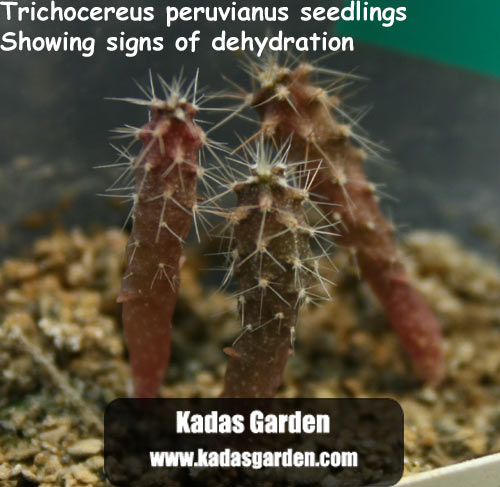
These Trichoceres seedlings are suffering from extreme dehydration. As well as their purple colour, notice their "wrinkles", far too young to have those!
This Lophophora williamsii is showing a lot of purple colour and also some wrinkles, caused by dry conditions. |
Mealy bugs | |
Appearance: Mealy bugs are a white fluffy looking bug. They have a cotton appearance. Up close you can see they look like a frosted sow bug. Males have wings and can fly, females are without wings. Damage caused: These are sucking bugs, meaning they suck juices from plants. They can do 2 things to hurt our plants (not just cacti): suck juices and leave little blemishes, they also spread plant disease by sucking a diseased plant then sucking a new plant, thus infecting it. Solutions: Luckily they are soft bodied and easily killed by hand. Unless your collection is large, killing by hand is relatively easy to do.. There are numerous chemical insecticides that do a number on these bugs, if your into that route. Removing lush growth around the cacti area will alo help keep numbers down. Prevention: They spread via other animals and also by themselves (not as much). Males are able to fly, females are not. They often attack lush growth so getting rid of large bushy plants around you cacti will help. Also keeping ants and other things that can carry these pests is a good idea. But in reality, if they are going to come, there is little to prevent them. Luckily they are easily controlled. They prefer dry, warm times...but will often attack despite that. Another great way is to use a liquid dishsoap. Mix the soap (use a water soap) with water and spray the affected cacti. Let sit for a day and rinse the soap off the cactus, this may take a few times to get them all. |

Close up of mealy bugs on an Agave plant. |
Stem Rot | |
Appearance: Generally stem rot starts low and works its way out and up, not always though. It is usually caused by fungus and can bee seen as dark brown-black spots/areas. As the fungi grows, it is doing so under the surface of the skin and for this reason is often worse than it appears from the outside. Causes: The more common fungal cacti pathogens ,Phialocephala virens, Lasiodiplodia theobromae and Fusarium species, generally need a point of entry. Cactus skin is generalyl quite thick and hard for many things to break through, including fungus mycellium, but if you cactus gets damage in teh skin, then there is an invitation for infection. Over watered cacti also tend to be prone to these fungi because they are so filled with water and bloated, so it is easier for the spores to germinate adn spread. Solutions: If the rotting spot is small, often times letting it dry out is enough. The problem with this kind of rot is its usually bigger and badder than it looks on the outside, often spreading throughout the cortex quite fast because it is so succulent and has little barriar against such pathogens. The skin is the main form of defense, and is also usually not as easy fo rthe fungus to colonize there therefor spread seems a *little* slower on the skin. The usually method for rot is surgery. you have to cut it out. Now keep in mind that once the area is vblack, its all dead, fungus included. The pathogen has eaten its meal and moved on. Fungi grow by mycellium, like roots kind of, so the active growing area of teh fungus is usaully still green and may appear to be healthy flesh on teh cactus. If you only cut away the brown and leave the bordering green, chances are it will keep rotting to nothing. Prevention: Obviously try not to let your cacti get damaged, but that happens. Also avoid over watering and keeping your soil wet. The best prevention for fungal attacks is keeping things dry and clean. |

1.1
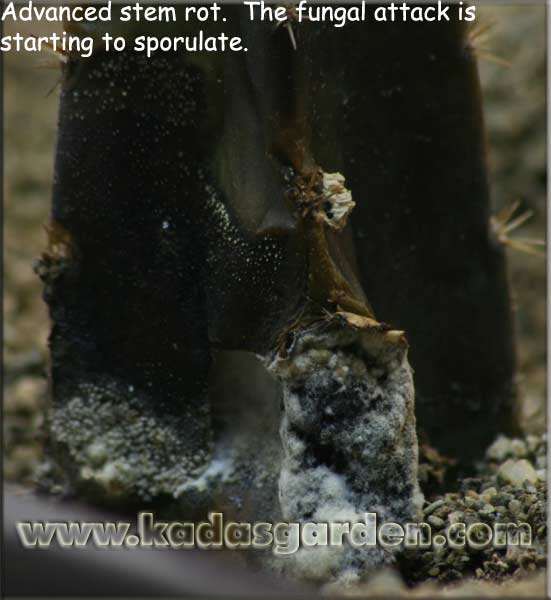

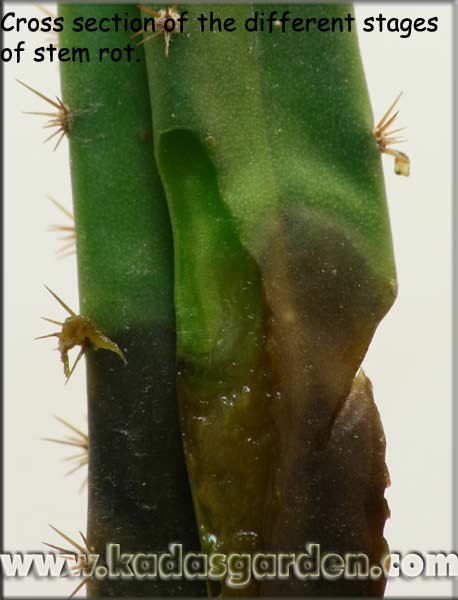
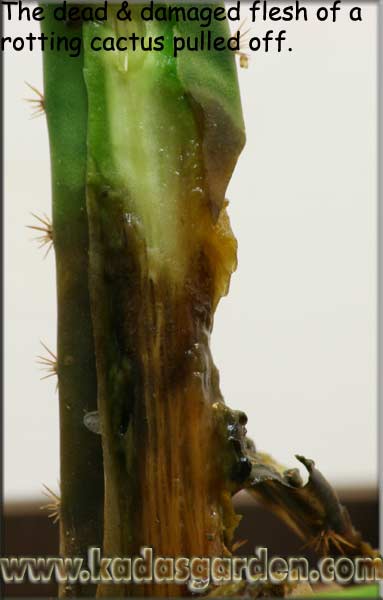
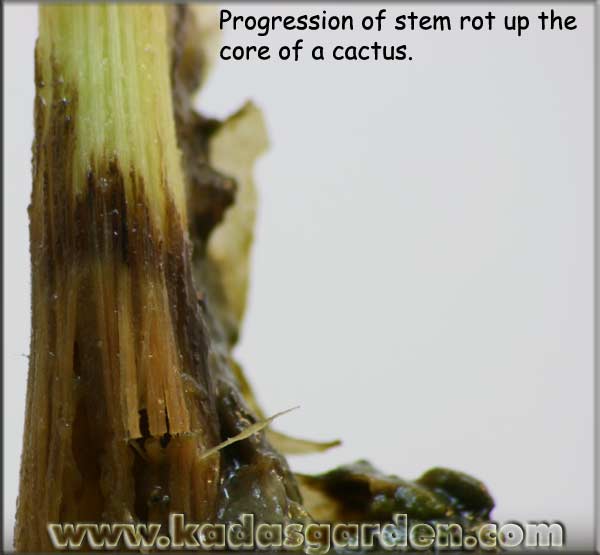
|
Grafting Rot | |
Appearance: When grafting, usually within weeks of doing so, sometimes the scion or stock's flesh turns colour to a red then brown and starts to shrivel. Usually when you seed that parts of the scion are "collapsing" and turning brown, this is rot. Causes: Almost every time this is caused by dirty grafting procedure and possibly too much humidity. When grafting its important to keep the blade super clean with alcohol wipes or similar disinfectant. Same as a human, if you cut yourself with something dirty, it will get infected. Cacti are the same. Sometimes other damaged will cause rot as well. Bumping the cactus or injuring it can cause rot, grafted or not. Too much sun (especially for low light level species and variegated cacti) can cause skin damage which may lead to rot in fresh grafts. Solutions: If the rot doesnt stop on its own, which it usually does not, try cutting out the rot (CLEAN BLADES!) and dusting with a sulphur powder. If the rot is set in and hits the vascular rings, its probably too late, but not always. If it is just on the outside there is often an 80% of survival, roughly. Prevention:Using CLEAN blades to graft, wiping between every cut or 2, is your best bet. Keep humidity down (unless the type of graft being done requires high humidity, in which case just try to prevent stagnant air). Do not harm or stress the cactus. Keep it shaded, and protected. It was just cut in half, give it some time. |
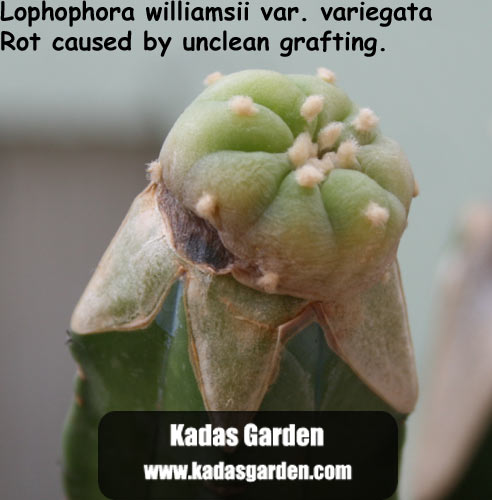
This variegated Lophophora williamsii was not grafted with a clean blade and became infected. Died soon after.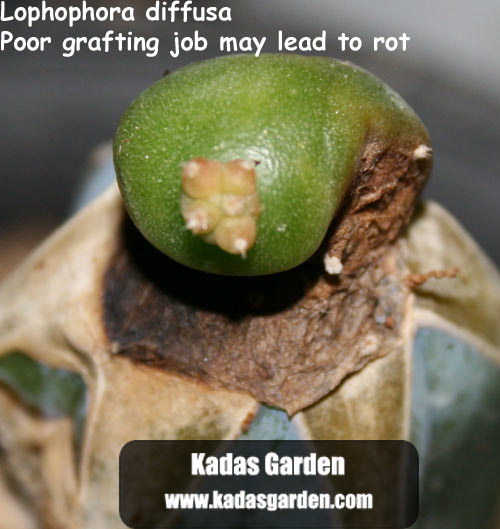
Not all are lost. This Lophophora diffusa lost 80% of its mass, but pupped once more after healing. |
| |
|
Appearance: Root rot can be very hard to tell until its too late. Aside from the roots often appearing dead (hard to tell when a plant is planted!), the stem of the cactus will also start turning a yellow colour and may become softer (your hard cactus is now more succulent feeling). The scary part with root rot is it works up the core of the cactus following the cambium. This causes the cactus to rot from the inside out, which makes it tricky to save. Watch for soft bases of the plants, a yellowing colour that is sort of mixed with green (not to be confused with sunburn) and in severe cases brown bases and squishy further up the plant. Causes: Usually root rot is caused by too much water. Damaged roots also help root rot set in. Things like broken roots while repotting, not well drained, root bound thus not draining water well, or pests in the soil. Solutions: If caught very early, which it rarely ever is, stop watering and let stay dry for a good period. Consider repotting into a new clean mix that allows more water drainage. Killing any and all pests. If it is more advanced, than surgery is all that's left. It is not time to save as much cactus as possible, its time to play it safe and cut out lots. If your cactus is 6cm tall and it is rotting 2cm up, cut away 4cm of cactus. You must cut away healthy green flesh to avoid it continuing. ALWAYS use a *clean* blade, wiping with alcohol is our preferred method. Once cut, apply a sulphur powder to prevent further rot. If that is not available, most rooting powders for plants have sulphur in them or similar fungicides that will help prevent any troubles. Prevention: When repotting, allow plants to dry a few days once out of the old pot before planting in new pot. Add more pumice and coarse sand to the mix, more drainage. Cut back on watering. And make sure there are no bugs or fungus growing inside the pot. Confused with: The soft tissue could be confused with lack of water as many cacti get softer when not watered much, but the feel is more "squishy" than lack of water. Also the yellow could be confused with too much light as some cacti burn or "bleach" under intense light. |

A root fungus caused this A. asterias to develop bad root rot. It died soon after.
3/4 of this L. williamsii was cut away and dusted with sulphur powder to prevent death. it took 14 months to root, but is now growing well, 2 years after the incident. |
Sunburn | |
Appearance: Cacti that recieve light that is too intense may do a few things. Seedling cacti will often turn a deep red colour, as can older specimens but not as often. Most older cacti, if truly burnt, will display a white colour on their epidermis. In extreme cases it will kill the flesh and be brown and hard (dead tissue). In more minor cases, as often witnessed in many columnar cacti, they may become a yellow colour. The normal green sort of fades to an extremely light green-yellow. This is not really too damaging but is a good sign that the plant is recieving too much light. Causes: Simple enough: too much light. Seedlings, and cacti that are used to lower light levels, are especially sensitive to higher light levels. Solutions: With seedlings, move them to a more shaded area or loose some light bulbs if using them. When moving cacti outside, say after winter dormancy, do so slowly. Slowly step up their light levels, bit by bit. Taking them from 6 hours of diffuse light a day to outside in the full summer sun is going to cause sunburn. We usaully adjust plants over a 1 month period to avoid such problems. Some plants just cannot take high light levels and should never be put in direct sun. Prevention: Adjusting plants to higher light levels over a longer period of time, and using a few steps to do so. Reducing light levels if too strong for that given specie. |

Notice the "bleached", or faded, appearance of this sunburnt Gymnocalycium.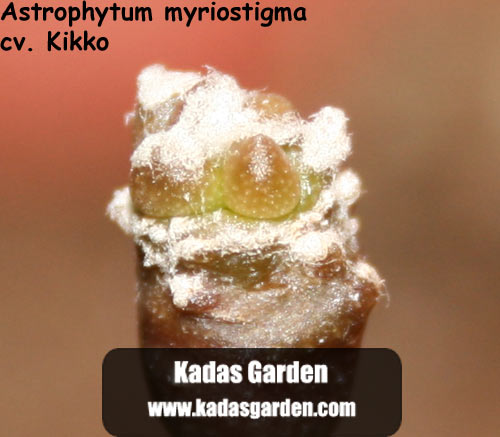
This Astrophytum myriostigma seedling is showing red colour, due to excessive light.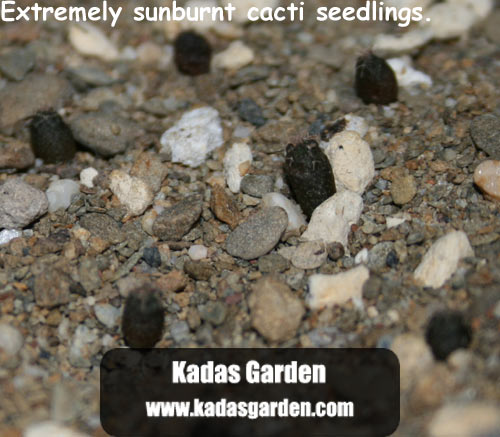
These seedlings are extremely sunburnt, almost black in colour! |
Appearance: Causes: Solutions: Prevention: |

|
